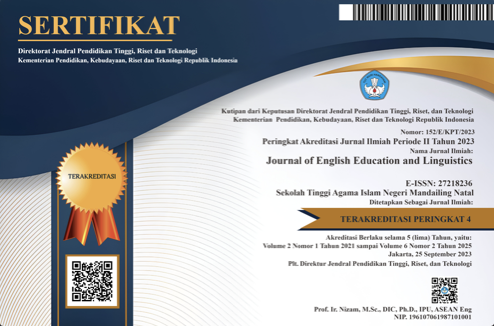EFFECTS OF TIKTOK ENGLISH TEACHING VIDEOS ON ELEMENTARY LEARNERS' SECOND LANGUAGE ACQUISITION
DOI:
https://doi.org/10.56874/jeel.v4i2.1411Keywords:
Second Language Acquisition, TikTok, TikTok English teaching videosAbstract
This study aimed to examine the Effects of TikTok English teaching videos in the Second Language Acquisition of Elementary Learners. The participants of this study were the 21 intermediate learners in Nababarera Elementary School, Baao, Camarines Sur. The researchers came up with the three main questions in this study: (1) What is the level of Second Language Acquisition of elementary learners during: a. Pre-Assessment b. Post-Assessment (2) Is there a significant difference between the raw scores of pre-assessment and post-assessment? (3) What are the challenges encountered in utilizing mobile phones as a tool for second language acquisition? The researchers used mixed method approach to answer the research questions. A pre- and post-assessment and a semi-structured interview were used as tools. It is discovered that learners who use mobile devices for language learning experience learning setbacks due to physical, pedagogical, and psycho-social issues. The result also showed that there is a significant difference between the raw scores of the learners’ pre- and post-assessment. Hence, TikTok can be an assessment tool for evaluating learners' language learning progress and an out-of-class learning tool to motivate and engage students in their English language skills development.
References
Al Momani, A. M. (2020). The Effectiveness of Social Media Application" Telegram Messenger" in Improving Students' Reading Skills: A Case Study of EFL Learners at Ajloun University College/Jordan. Journal of Language Teaching and Research, 11(3), 373-378.Bagabaldo, A. (2004). Developing Reading Power 2.
Bagabaldo, A. (2004). Developing Reading Power 2.
Bevans, R. (2020). An Introduction to t Tests | Definitions, Formula and Examples. Scribbr. https://www.scribbr.com/statistics/t-test/#:~:text=A%20t%20test%20is%20a
Cagoco-Guiam, R. (2022, September 13). Rays of hope. INQUIRER.net. https://opinion.inquirer.net/156923/rays-of-hope
Hassan, I., BaraU Gamji, M., Yahaya Nasidi, Q., & Latiff Azmi, M. N. (2021). Challenges and benefits of web 2.0-based learning among international students of English during the Covid-19 pandemic in Cyprus. Arab World English Journal.
K12 Reader (2014). Figurative Language.Retrieved from https://www.k12reader.com/worksheet/figurative-language-what-is-it/view/
K5 Learning (n.d.). Figurative Language. Retrieved from https://www.k5learning.com/worksheets/reading-comprehension/grade-5-metaphors-similes-a.pdf
Krashen S., & Terell T. (1983). Stage of Second Language Acquisition. (n.d.). Retrieved November 29, 2022, from https://spgtherapy.com/wp-content/uploads/2019/04/Stages-of-Second-Language-Acquisition.pdf?fbclid=IwAR2gJwWYcZcIdcJ3UA7k4i_EU7YJ1hZ-2LcpgYUDXikJ21d2H6PMBWD9trQ
Opsahl, M. K., & Levin, H. (2022). Trending: A New Way of Language Learning: Students' Language Acquisition Through TikTok (Master's thesis, University of South-Eastern Norway).
Pikhart, M., & Botezat, O. (2021). The impact of the use of social media on second language acquisition. Procedia Computer Science, 192, 1621-1628.
Prasetiawan, D. (2017). Pemerolehan bahasa pada anak suku Sasak dalam perspektif Psikolinguistik. Jurnal Pendidikan Bahasa dan Sastra, 17(1), 72-80.
Rahmawati, Y., & Anwar, K. (2022). TThe Use of TikTok Application: The Impact on Students’ Vocabulary and Attitude. Project (Professional Journal of English Education), 5(3), 610-621.
Revesencio, N. I., Alonsagay, R. R., Dominguez, L. I., Hormillosa, D. M. I., Ibea, C. H. I., Montaño, M. M. S., & Biray, E. T. (2022). TikTok and Grammar Skills in English: Perspectives of English Major Students. International Journal of Multidisciplinary: Applied Business and Education Research, 3(11), 2226-2233.
Sirisilla, S. (2022, November 10). Experimental Research Designs: Types, Examples & Advantages. Enago Academy. Retrieved from https://www.enago.com/academy/experimental-research-design/?fbclid=IwAR3N1eGNRheIDy2_qcqwIeiLoPn7Cl9ebwQBcLphY3A7ptLmA7lAHzIsPPo#:~:text=Experimental%20research%20design%20is%20a
Stockwell, G. (2022). Mobile assisted language learning: Concepts, contexts and challenges. Cambridge University Press.
Stockwell, G., & Hubbard, P. (2013). The International Research Foundation for English Language Education Some Emerging Principles for Mobile-assisted Language Learning.
Sundqvist, P., & Sylvén, L. K. (2016). Extramural English in teaching and learning: From theory and research to practice. Springer.
Tangirbergen, T. (2022). Teachers’ experiences of, challenges, and attitudes towards using mobile applications for teaching English as a foreign language in Kazakhstan.
Umah, R. Y. H., & Anggraini, Y. (2022). Potential Utilization of Tiktok as Learning Support Media in Elementary School. In Proceeding: International Conference on Islamic Studies (ICIS) IAIN Ponorogo (pp. 178-185).
Xiuwen, Z., & Razali, A. B. (2021). An overview of the utilization of TikTok to improve oral English communication competence among EFL undergraduate students. Universal Journal of Educational Research, 9(7), 1439-1451.
Yang, H. (2020, June). Secondary-school Students’ Perspectives of Utilizing Tik Tok for English learning in and beyond the EFL classroom. In 2020 3rd International Conference on Education Technology and Social Science (ETSS 2020) (Vol. 1, pp. 162-83).
Yélamos-Guerra, M. S., García-Gámez, M., & Moreno-Ortiz, A. J. (2022). The use of TikTok in higher education as a motivating source for students. PORTA LINGUARUM, 38, 83-98.
Zain, D. S. M., & Bowles, F. A. (2021). Mobile-assisted language learning (Mall) for higher education instructional practices in efl/esl contexts: A recent review of literature. Computer Assisted Language Learning Electronic Journal, 22(1), 282-307.
Zaitun, Z., Hadi, M. S., & Indriani, E. D. (2021). TikTok as a Media to Enhancing the Speaking Skills of EFL Student's. Jurnal Studi Guru Dan Pembelajaran, 4(1), 89-94.
Downloads
Published
Issue
Section
License
All articles published in the Journal of English Education and Linguistics are licensed under a Creative Commons Attribution-ShareAlike 4.0 International (CC BY-SA) license. This means anyone is free to copy, transform, or redistribute articles for any lawful purpose in any medium, provided they give appropriate attribution to the original author(s) and Journal of English Education and Linguistics, link to the license, indicate if changes were made, and redistribute any derivative work under the same license.
Copyright on articles is retained by the respective author(s) without restrictions. A non-exclusive license is granted to the Journal of English Education and Linguistics to publish the article and identify itself as its original publisher, along with the commercial right to include the article in a hardcopy issue for sale to libraries and individuals.
Although the conditions of the Creative Commons Attribution-ShareAlike 4.0 International (CC BY-SA) license do not apply to authors (as the copyright holder of your article, you have no restrictions on your rights), by submitting to the Journal of English Education and Linguistics, authors recognize the rights of readers and must grant any third party the right to use their articles to the extent provided by the license.

This work is licensed under a Creative Commons Attribution-ShareAlike 4.0 International License.








